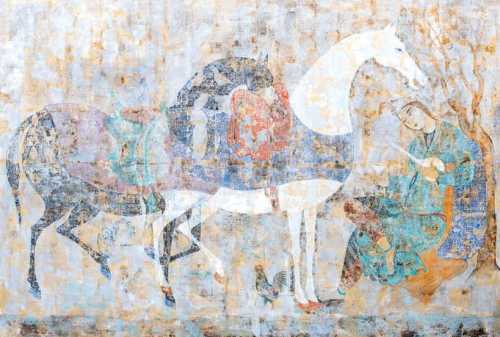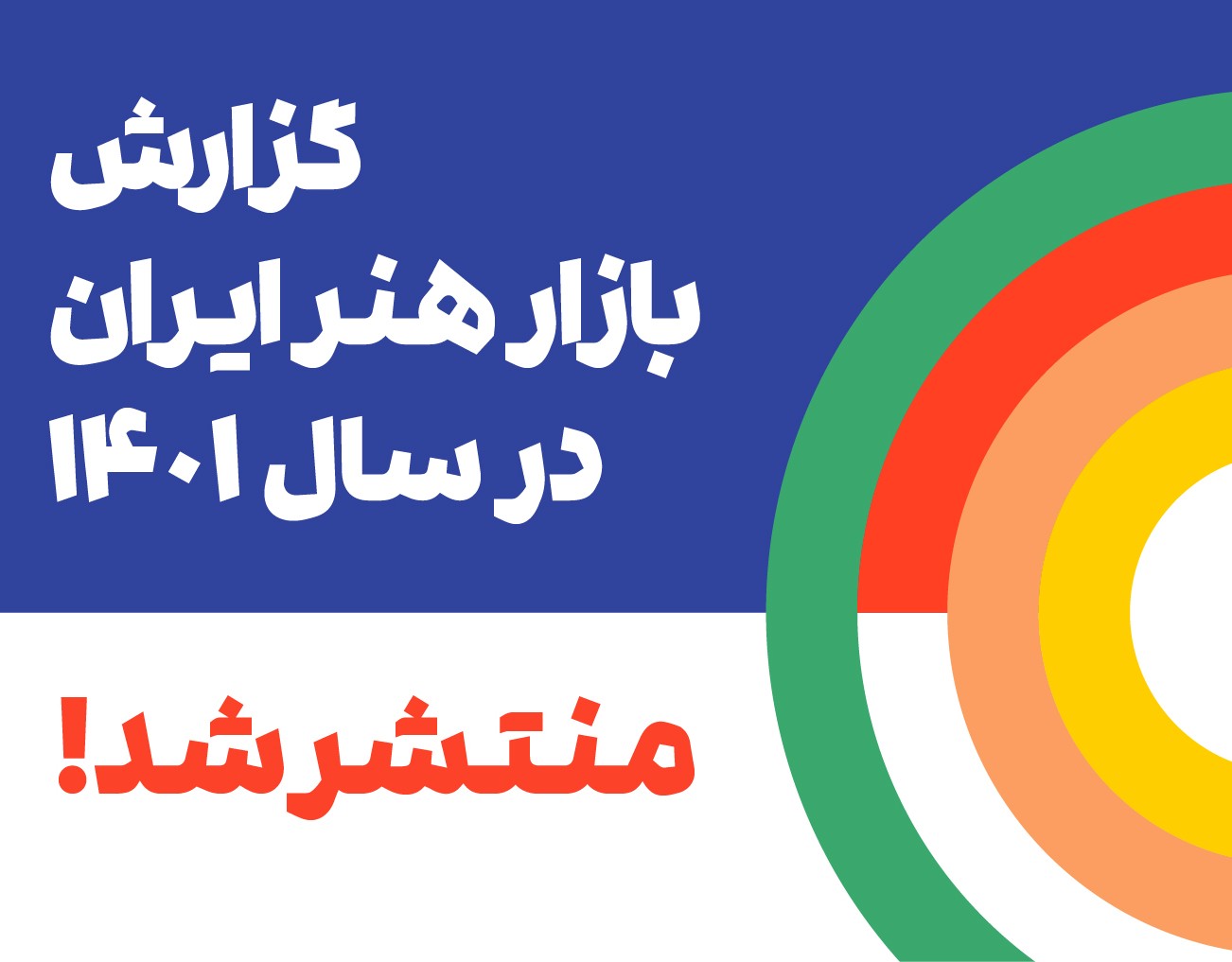About Mohammad Hadi Fadavi
Mohammad Hadi Fadavi, an Iranian neo-traditional painter, was born in Arak. From his childhood, through one of his relatives who worked in handicrafts, he became interested in the work of market painters and copyists. He started learning the basics of painting with educational books and got involved in oil painting. At the same time, he got acquainted with the works of Van Gogh and Cézanne, and later he would take orders for portraits.
Fadavi studied Persian literature, saying that literature, especially Hafez, had a significant influence on his paintings. At the same time as the events of 1979 and the cultural revolution, he turned to cinema due to his familiarity with painting and had experiences in various fields such as set design and costume design. In cinema and television, he collaborated with artists such as Dariush Farhang, Ebrahim Hatamikia, and Kyomarth Pourahmad. In a project called "Gallery 9", he studied and copied nearly 100 paintings, including "Doctor Gasche" by Van Gogh. The financial independence and free time provided to him by making a living through cinema allowed him to recover and pursue his artistic ideas in painting. He pursued painting with interest and tried to promote this abandoned art style by inventing a new language. Finally, he devoted himself to the art of painting because he had no middle ground with the economic atmosphere of cinema. His first solo exhibition was held in 1994 in his hometown's Gallery, Arsha. In 2005, he exhibited his works in Niavaran Book City.
Fadavi studied Persian literature, saying that literature, especially Hafez, had a significant influence on his paintings. At the same time as the events of 1979 and the cultural revolution, he turned to cinema due to his familiarity with painting and had experiences in various fields such as set design and costume design. In cinema and television, he collaborated with artists such as Dariush Farhang, Ebrahim Hatamikia, and Kyomarth Pourahmad. In a project called "Gallery 9", he studied and copied nearly 100 paintings, including "Doctor Gasche" by Van Gogh. The financial independence and free time provided to him by making a living through cinema allowed him to recover and pursue his artistic ideas in painting. He pursued painting with interest and tried to promote this abandoned art style by inventing a new language. Finally, he devoted himself to the art of painting because he had no middle ground with the economic atmosphere of cinema. His first solo exhibition was held in 1994 in his hometown's Gallery, Arsha. In 2005, he exhibited his works in Niavaran Book City.
Animal motifs such as fish, owl, and rooster play a prominent role in his works. Later, the cypress (tree of life) entered his works in linear form, and horses gradually became the main elements of his paintings. Encountering one of Sharafoddin Hosseini's horse paintings (Qazvin School) in the Hermitage Museum deeply impacted him. This was an introduction to his focus on horse motifs and the study of how they were represented and finished in different periods of Iranian painting history. The result of this investigation period was finally published as an article in the "Shadow Art" magazine.
Gradually Fadavi tried to bring human beings into his frames, and by adopting some characteristics of Reza Abbasi and Kamaloddin Behzad's miniatures, he created a revolution in painting and freed it from self-restraint and repetition. In this way, he moved towards a modern and decorative perception of painting. He defends this quality by admitting that his works are decorative and considers them a conscious feature. Because he believes that art, more than the commitment to expressing a political or social issue, is required to be beautiful and sweet to provide the audience's pleasure, a rule that he follows seriously in his works of art.
Gradually Fadavi tried to bring human beings into his frames, and by adopting some characteristics of Reza Abbasi and Kamaloddin Behzad's miniatures, he created a revolution in painting and freed it from self-restraint and repetition. In this way, he moved towards a modern and decorative perception of painting. He defends this quality by admitting that his works are decorative and considers them a conscious feature. Because he believes that art, more than the commitment to expressing a political or social issue, is required to be beautiful and sweet to provide the audience's pleasure, a rule that he follows seriously in his works of art.
The Most Expensive Artwork
At Auctions
First Attendance
23 April 2020
# Attendance
11
# Artworks
14
Average Realized Price
6,348 USD
Average Min Estimate
3,863 USD
Average Max Estimate
5,711 USD
Sell-through Rate
78.571%
Average Growth of Artwork Worth
28.139%
Timeline
Arts Of The Islamic Land auction
16 December
CHARSOO- Part 2 exhibition
3 October
Modern and Contemporary Art auction
30 September
The 23rd Tehran - Modern and Contemporary Iranian Art auction
22 May
Fine Islamic & Indian Works Of Art auction
6 May
Annual 2025 exhibition
7 March
Renewed exhibition
7 March
In Memory of Hadi Jamali 2 exhibition
17 January
A Tree-Rich Garden exhibition
15 November
The 21st Tehran - Contemporary Iranian Art auction
11 October
Riderless Horses exhibition
20 September
Resize exhibition
16 August
The 20th Tehran- Modern and Contemporary Iranian Art auction
5 July
10s of Artworks, 10s of Millions exhibition
8 March
The 18th Tehran Contemporary Art auction
12 December
Arthibition auction
20 October
Riderless Horses exhibition
1 September
Tehran- 16th- Iranian contemporary art auction
1 July
XL exhibition
20 May
The VenoArt Mother's Day auction
1 May
Opportunity exhibition
13 February
Group Painting Show Negar exhibition
28 January
From Object to Figure exhibition
24 September
Show and Sell of Works for the Benefit of Corona Patients exhibition
24 April
No.3 auction
23 April
Kado Art 2.2 exhibition
28 February
Frame 50 exhibition
21 February
No Rider Horses exhibition
14 February
Art Throught the ages exhibition
10 January
White Black Gray exhibition
13 December
Where Did the Riders Go? exhibition
6 December
Two Out of Thousands exhibition
1 November
Mohammad Hadi Fadavi - Solo Exhibition exhibition
22 February
In Memory of Sherveh exhibition
2 November
In Memory of Sherveh exhibition
28 September
Summer Sale of Artibition exhibition
7 September
Horses With No Riders exhibition
31 August
Shams gallery Collection Special Sale exhibition
7 July
Mohammad Hadi Fadavi's Paintings exhibition
24 February
Articles
Iranian Art Market Report for the Year 1401 SH 15 May 2023
When the Art Hall team was looking for the Iranian artworks' sales records for art appraisal, felt the void of an authoritative art reference. That's why Artchart was born in 2019. The purpose of launching Artchart was to create a database of the Iranian art market that can be used as a reference for a wide range of people, from artists to art collectors. Now Artchart has collected...

